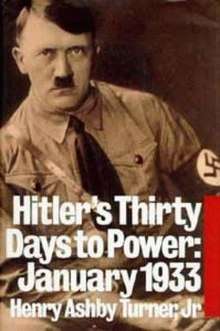Hitler's Thirty Days to Power
Hitler's Thirty Days to Power is a 1996 history book by historian and Yale professor Henry Ashby Turner. The book covers political events in Germany during the month of January 1933, which culminated in the appointment of Adolf Hitler as chancellor on January 30.
 Cover of the first edition | |
| Author | Henry Ashby Turner, Jr. |
|---|---|
| Cover artist | Robert Dietz |
| Country | United States |
| Language | English |
| Subject | Adolf Hitler |
| Published | 1996 (Addison-Wesley) |
| Media type | |
| ISBN | 9780201407143 |
| OCLC | 34753374 |
| 943.085 | |
| LC Class | DD247.H5T79 |
In Hitler's Thirty Days to Power, Turner concludes that Hitler's rise was not inevitable,[1] but that the end of the Weimar democracy probably was: Turner speculates that by 1933 the likely alternative to Hitler was a Kurt von Schleicher-led military regime, which Turner believes would have confined its territorial ambitions to the recovery of the Polish Corridor, leading to a limited German-Polish conflict but not a general European war – an unfolding of events where, in Mark Grimsley's characterization of Turner's conclusions, "Adolf Hitler would have become a mere footnote in history".[2]
The book was reviewed by many important publications, including Foreign Affairs (by Stanley Hoffmann),[1] The Times Literary Supplement,[3] Booklist,[4] The New York Review of Books (by Gordon A. Craig),[5] Kirkus Reviews,[6] History and Theory[7] and other publications. Historian and Hitler biographer Alan Bullock called Hitler's Thirty Days to Power "[T]he best and fullest account of the 'make or break' month of January 1933".[3]
Editions
- Turner, Henry Ashby (1996). Hitler's Thirty Days to Power. Boston: Addison-Wesley. ISBN 978-0201407143. (Hardcover)
- Turner, Henry Ashby (1996). Hitler's Thirty Days to Power. London: Bloomsbury. ISBN 978-0747530046. (Hardcover)
- Turner, Henry Ashby (1997). Hitler's Thirty Days to Power. New York: Basic Books. ISBN 978-0201328004. (Paperback)
- Turner, Henry Ashby (2003). Hitler's Thirty Days to Power. Castle Books. ISBN 978-0785816850. (Hardcover)
References
- Stanley Hoffmann (May–June 1997). "Hitler's Thirty Days to Power: January 1933". Foreign Affairs (May/June 1997). Retrieved March 30, 2014.
- Mark Grimsley (August 10, 2012). "What If Hitler Had Not Come to Power?". HistoryNet. Weider History Group. Retrieved March 30, 2014.
- "Hitler's Thirty Days to Power". Writer's Reps. New York: Writers Representatives, LLC. Retrieved March 30, 2014.
- Booklist Review - Hitler's Thirty Days to Power: January 1933. Booklist. American Library Association. October 15, 1996. Retrieved March 30, 2014.
- Gordon A. Craig (May 29, 1997). "Becoming Hitler". New York Review of Books. Retrieved April 1, 2014.
- Hitler's Thirty Days to Power. Kirkus Reviews. Retrieved March 30, 2014.
- Lindenfeld, David F. (October 1999). "Causality, Chaos Theory, and the End of the Weimar Republic: A Commentary on Henry Turner's Hitler's Thirty Days to Power". History and Theory. 38 (3): 281–299. doi:10.1111/0018-2656.00092. JSTOR 2678084.